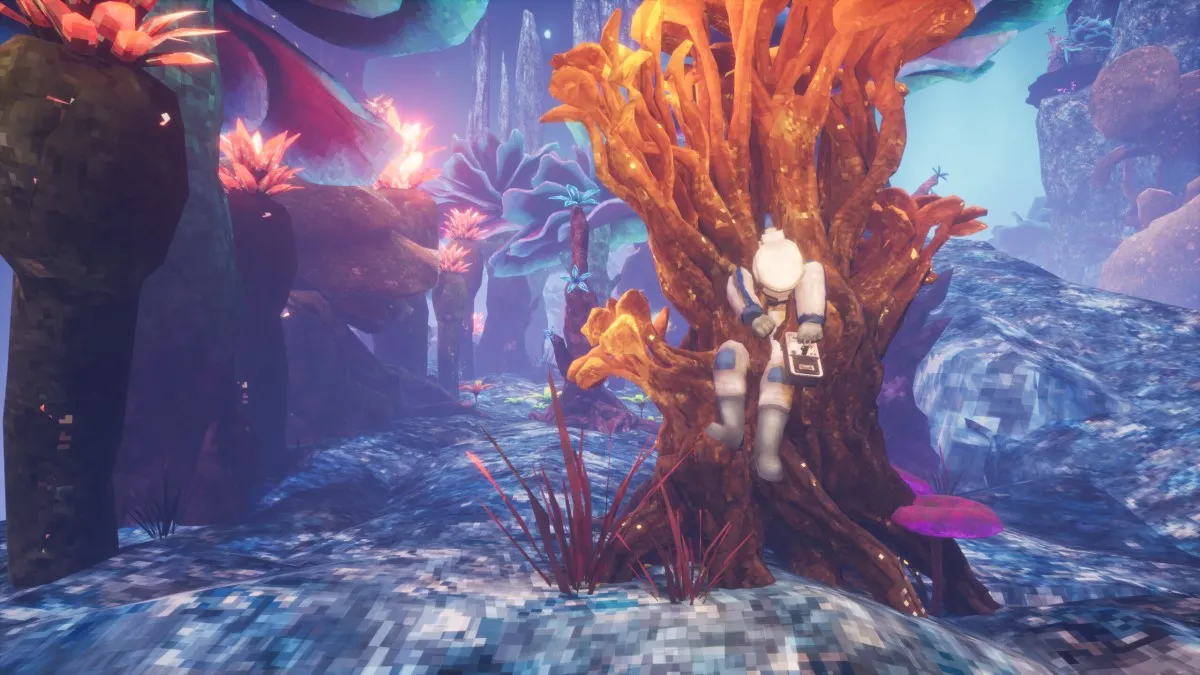Infragood
During the first fifteen minutes of Ultraworld, I was blown away by how bad it was. It was “you have got to be kidding me; this must be a joke; one out of ten” bad. The gameplay was trite, and it was matched with some of the most inane, pseudo-intellectual drivel in recent memory.
Fortunately, it gets better. After a fourth wall-breaking twist, the game opens up and becomes more enjoyable as a relaxed exploration game through its sharply colored world. However, better than terrible can still be pretty bad.

ULTRAWORLD (PC)
Developer: Neon Serpent LLC
Publisher: Neon Serpent LLC
Released: December 4, 2014
MSRP: $14.99
Rig: AMD Phenom II X2 555 @ 3.2 GHz, with 4GB of RAM, ATI Radeon HD 5700, Windows 7 64-bit
The player’s first interactions with Ultraworld should be a sign of the quality. Right on the Steam page, developer Neon Serpent notes that there is an unpatchable bug that needs to be dealt with before playing. Once the game is going, display settings and other options cannot be modified; players must quit out entirely and restart in order to access the main menu. Neither of these are gamebreaking, but they do betray an amateurishness in the development.
After that, things briefly start to look up. The player is inserted into a film grain-filtered, low-polygon environment that is visually interesting in spite of its low quality by traditional standards. After completing the first objective, it goes downhill again.
The player is instructed to find four doors and view scenes at each one. The downfall here is that the doors are in obvious positions, arranged regularly around the center of the hub area. There is no skill, thought, or real exploration necessary. Just: walk to this door, touch the black pyramid, watch a barely interactive cutscene, repeat.
To make it worse, the first four scenes teleport the player to another area, disallow any movement, and consist of hackneyed, Kingdom Hearts-esque, high school level philosophical ramblings. “Who am I?” “What is real?” These are actual quotes from this section of the game. Without any extra context, they just come off as lazy filler text to make the author appear more thoughtful than he is.
At this point, I was almost ready to just call it quits and can this review. If this were all Ultraworld has to it, then it would be the worst game I have played all year. I pushed through these banal first scenes expecting the credits to roll and for me to feel like I wasted a portion of my life.
Thankfully, it gets better. After the first four black pyramids to touch have been touched, twelve more appear in the hub world, but in places that are not as blatantly obvious as the previous ones. Actual exploration is required for these. Climb a hill to get a better view of the area. Check that nook over there. Try to get around this barrier. See what is at the bottom of this tunnel.

The scenes that trigger become more interactive as well. Instead of having only a stationary view, the player can navigate these scenes like the hub world, and find (surprise) more black triangles to touch in order to advance the narrative.
That narrative is still full of clichés, and Ultraworld even calls itself out in that regard, pointing out its “dime-store philosophy.” Though it does not improve the quality of the writing, it at least shows that the author is self-aware. And to be fair, the eyeroll-inducing questions introduced in the beginning are eventually relevant to the story once the player has more context from these additional scenes.
For those who go the extra mile in exploring, there is another character to interact with. He is never impossible to find and he has his own subplot that threatens to be interesting, but ends without a very satisfying resolution.

If I had one nice thing to say about Ultraworld, it is that it is pretty. Even though the environments are made up of only a few polygons, they employ various lighting conditions and visual filters in order to remain interesting. Some of them are beautiful in their own blocky way. Exploration just to see the scenery can be worthwhile in some cases.
In the end, that unique beauty cannot save Ultraworld. The areas are too small and often too linear to be worth exploring for longer than necessary, and the dull philosophical narration drags the whole experience down. Although it picks up after the first section, there is still not a lot to enjoy here.
[This review is based on a retail build of the game provided by the publisher.]





Published: Dec 8, 2014 12:00 pm